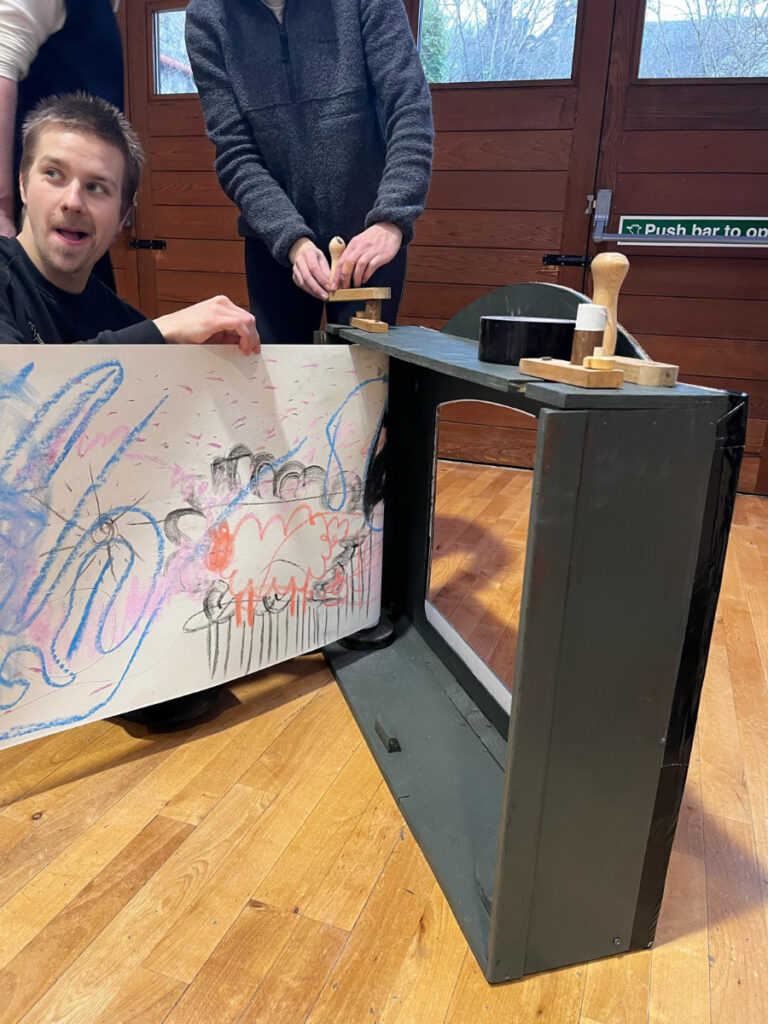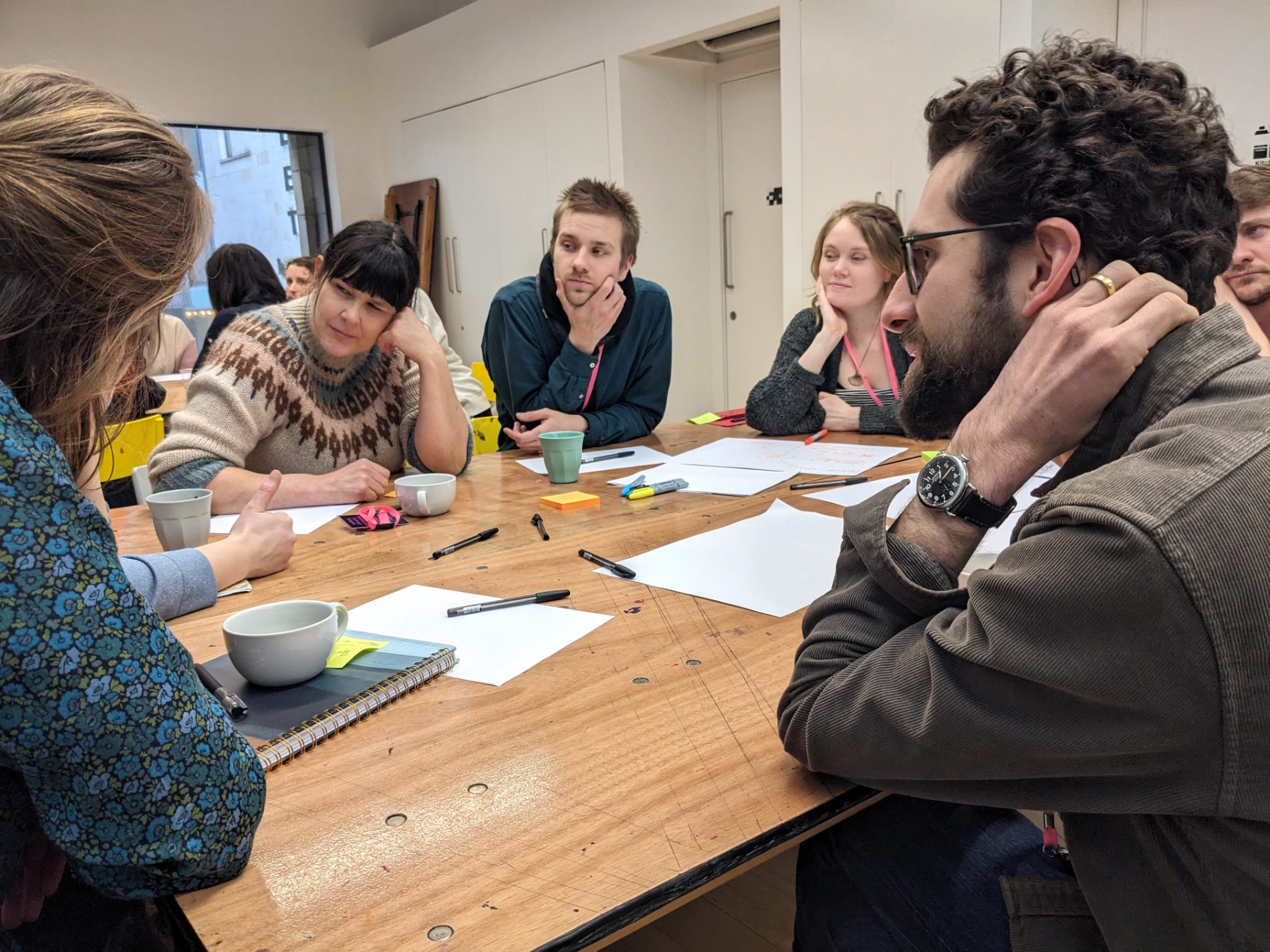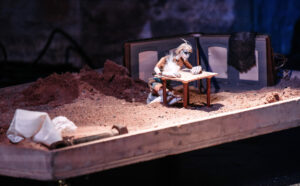Text: Valtteri Alanen
In the beginning of February 2024 I had the joy of taking part in the artistic exchange “Dialogues of the In-Between” hosted by the Manipulate Scotland festival in Edinburgh. I also enjoyed the chance to see performances at the festival. My week in Edinburgh, supported by Manipulate Arts Scotland and Aura of Puppets was great: first a weekend of shows and then three days of sharing artistic practices with other attendants. I will report it all in more detail in the following. Let’s dive in!
A varied, welcoming, and expertly curated festival of puppets, objects, people and performing arts
Upon arriving in Edinburgh, my first time in Scotland, the first thing I noticed was the almost permanent overcast and light drizzle, but even more the fact that Edinburgh in itself is beautiful. For a lover of well preserved old towns and good hills, Edinburgh had it all. The messy verticality of the historical center is dizzying. As I discussed with Dylan, one of the artists in our exchange, it feels that no building of their age has any business being so tall – built on the side of a hill, many places feel like small skyscrapers on one side, and like a normal three storey townhouse on the other. Also, the streets are pretty, the graveyards gloomy and there’s a grand old castle stuck atop a big volcanic rock. What more can one wish for? Well, a good festival might not be too much to ask, right?
Luckily, that is exactly what we had. Manipulate Scotland hosted a varied, welcoming, and expertly curated festival of puppets, objects, people and performing arts. The size of the festival makes it also very admissible to a first timer. There is a lot to see and experience at the festival, but still the organization size and distances between events retain a feeling of intimacy and approachability. Not too small, not too big, much like the city it is hosted in. Regarding the expert curation of the festival, one thing stood out to me, among the puppets and visual performances of this year: robotics.
Robots taking over
If programming of Manipulate Scotland is anything to go by, robots have officially made it in puppet theater. Two of the main festival shows had robots as main performers: L’amour du Risque by Compagnie Bakelite was a hilarious, absurd deadpan slapstick with one human performer and several robot vacuums who made an abysmal effort at serving a dinner. The robots did most of the slapping, while the human (brilliant Olivier Rannou) did the sticking. Also, Simple Machines by Kwaad Bloed had robots as its main actors. And here I mean actors as in beings with agency pushing the show and the research behind it forward, not as some boring humans reciting the lines of, say, Lady Macbeth. That is not to say that the choreographer-turned-mad-robot-scientist Ugo Dehaes isn’t instrumental for the robots or the performance to do their thing, but that it seems clear that the physical possibilities and performative tendencies of the robots come across as the crucial driving force for the show.

I was also lucky to witness two works in progress in the festival that were explicitly concerned with robotics: I, Honeypot by the talented Nikhita Devi explored the ascension to self-awareness of an entertainer robot specifically skilled in Indian classical dance, and Hover by Althea Young featured a video-graphing drone as the antagonist. Appearing part big brother, part an obsessive-toxic lover, the hovering quadcopter circled, swooped, spied and followed the humans in the room, performer and audience alike. Granted, a drone is more of a remote controlled machine than an autonomous robot, and as such closer to a traditional puppet than, say, a robot vacuum. Nevertheless, the mechanical appearance of one, with a hidden manipulator, is unequivocally invoking the imagination of a robot rather than that of a marionette. As with Honeypot the entertainer-robot, who was embodied by a human performer, it does not take an actual robot to manifest robotics on the stage. We are in the theater, after all.
Dialogues of the In-Between
In addition to the robots, the festival also hosted a plethora of great puppetry and visual theater. But what I was there for most of all, was Dialogues of the In-Between – an international exchange for artists and festival programmers, organized by Manipulate Scotland in co-operation with Aura of Puppets, FIDENA and Go Figure Oslo. The artists and festival-programmers had their own separate sessions during the days, after which we all came together for a big common discussion to wrap up the day’s activities.
We in the artist-group spent three exciting days in a studio of Dance Base Scotland, sharing time, glimpses and tools of our artistic practices and some good old human energy. The exchange was generously facilitated by Al Seed, led by whom we started everyday with a discussion and some light games. The bulk of the day was divided in two or three workshops or sharing sessions of artistic practices. We made messes, devised real fast, moved around in all kinds of ways, learned a bit about classical Indian dance and listened, sang and talked some more. I am very grateful for meeting all the great people in the exchange, and for having a chance to share in their artistic practices. The possibility to spend some time with other people just doing stuff – doing things that don’t necessarily need to be reducible to any goals or grand purpose beyond doing the things themselves – is a great privilege, for an artist and a human being. Coincidentally, I believe this to be something emblematic of good art: a practice that does not resolve into anything outside or, heavens forbid, above itself. Art happens for art to happen, and all the beautiful, beneficial and brilliant things that follow are just accidents we wish for. That is not to say that art should be pure self-reference, on the contrary, as was clear in meeting other artists from different backgrounds, places and other contexts.

Picture by Marianne Stranger
One personal example of this from the exchange: Nikhita Devi gave us a short introduction to Classical Indian Dance, and especially to different Mudras, or specific postures for the hands central to the physical vocabulary of the tradition. After spending some time and thoughts on the mudras, Nikhita directed us to play around with an exercise where a partner guides, or animates, another with their hands but without touching the partner. The animated partner follows intently how the positions of the hands change in relationship to the space and the participants bodies, and reacts accordingly with their own body. Standard puppet- and physical theater performer training stuff, and an exercise I already thought I had done enough of in my years of studies to never find anything novel in it ever again. But wouldn’t you know, just placing the exercise into the new context of being led by a person who just before gave us a short introduction on mudras revealed a plethora of new tacit effects in the exercise. It is hard to describe them here in text and word, but somehow the theoretical framework primed me to experience and go through the exercise with new eyes – or should I say new hands? It must also be added that there was no indication that mudras should somehow be practically implemented in the exercise. Just the lingering consciousness of different forms of utilizing the same tools – like hand postures and movements – in another way, changed a lot. Almost everything.
Exchanges with colleagues in different art fields
Apart from the actual sessions of sharing, we also had the privilege of taking part in talks with our fellow artists and the programmers, who had their own activities during the day. We spoke a lot about cross border collaborations, conditions for creating in our respective localities and about possible ways of improving these circumstances.
Some thoughts that have kept running a circle in my head from those conversations deal with the difficulty of naming this thing that we do – both for ourselves and to our audiences as well as our funders. Curiously, even though the participants were artistically working in seemingly very different formats – physical theater, dance, puppetry, fine arts, contemporary circus and so on – something in the paradigm in which we all work seemed to resonate so easily that in the exchange it would have been very hard, if not impossible to tell what anybody’s respective background was.
We spoke of visual theater, as a possible umbrella term connecting our various disciplines (and one that is indeed used to an extent in Britain at least), but some of us felt it lacking accuracy, even though it also held some truth. For myself, visual theater feels weird simply for the fact that in my own work I tend to prioritize the aural medium over the visual one. I now also realize no one brought up postdramatic theater as an alternative umbrella for performing arts outside text based, writer dominated narrative theater. This is not to say that the post-dramatic also doesn’t hold its own complications as a term. Marianna Strangers suggestion of terming one’s work as anti-visual theater felt very resonant with my own work, and suggestive of rich imaginations of performance – but also antithetical to the practices of many other artists present.
I am tending towards an observation that our art form, whatever one may call it (I guess for me it has been contemporary / experimental puppetry or contemporary performance for a lack of better name) is currently grappling with a slow burning crisis of identity. This is evident in how for example what we would call puppetry in my native Finland, where I also began my studies with the artform, would not always get recognised as such for example in Czech Republic where I concluded my MA in Object theater and devising. Are robots for example puppetry or are they something else altogether? Perhaps dancers, as they were presented in the words of Ugo Dehaes? Do they become puppetry (or visual theater for that matter) just by virtue of being programmed at a festival traditionally hosting a lot of puppetry? For many makers the question seems of little practical importance, and understandably so.

Often I hear a performing artist say that they are happy to show their work in the context of any festival that finds them suitable. If robots are programmed by contemporary puppetry festivals then so be it – an artist tends to be happy to exist in a context that pays them and lets them do what they do. Yet, contextualizing and naming things has value, not the least of which is in helping us find the right audience and funding for our work. And the right collaborators and colleagues.
The questions in my head are still moving around unanswered. Not that they necessarily need to find absolute answers. Perhaps one of the values of the exchange is in finding the right questions. While my time in Scotland stirred some healthy suspicions of the theoretical frameworks and contexts I apply to my work and my colleagues, it also happily provided something new in the way of solidity, dependability and enjoyability. All of the contacts made, the experiences accumulated and the ideas shared are already forming a base for something good in the future, whether in concrete collaboration with people we met at the festival or not.
It has also been very refreshing to make these connections and explore artistic practices across quite imaginary seeming borders between art forms and politically enforced ones between countries, and get yet another reminder of the fact that staying stuck inside one’s boundaries, whether real or invented, is rarely beneficial for the development of artistic practice. And that while grass is rarely greener on the other side of the fence, the way they do the gardening is most probably very interesting and worth learning from. Maybe even interesting enough to contemplate dismantling that old fence completely. You might just end up with an unexpected performance of your robot lawnmowers meeting for the first time, or who knows whatever else!





